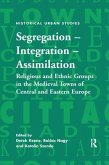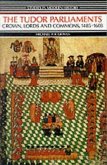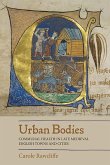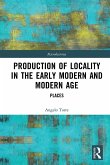Lords and Towns in Medieval Europe
The European Historic Towns Atlas Project
Herausgeber: Simms, Anngret; Clarke, Howard B.
Lords and Towns in Medieval Europe
The European Historic Towns Atlas Project
Herausgeber: Simms, Anngret; Clarke, Howard B.
- Gebundenes Buch
- Merkliste
- Auf die Merkliste
- Bewerten Bewerten
- Teilen
- Produkt teilen
- Produkterinnerung
- Produkterinnerung
This volume is the first publication to draw upon the mass of information provided by the Historic Towns Atlases in order to explore comparative questions in medieval urban history. The volume addresses the wider question of comparative urban studies, the processes that determined the morphological formation of towns, and the symbolic meaning of large-scale town plans in their cultural context.
Andere Kunden interessierten sich auch für
![Segregation - Integration - Assimilation Segregation - Integration - Assimilation]() Segregation - Integration - Assimilation46,99 €
Segregation - Integration - Assimilation46,99 €![Archaeology in British Towns Archaeology in British Towns]() Patrick OttawayArchaeology in British Towns78,99 €
Patrick OttawayArchaeology in British Towns78,99 €![Minoans Minoans]() Rodney CastledenMinoans61,99 €
Rodney CastledenMinoans61,99 €![Tudor Parliaments, The Crown, Lords and Commons,1485-1603 Tudor Parliaments, The Crown, Lords and Commons,1485-1603]() Michael A.R. GravesTudor Parliaments, The Crown, Lords and Commons,1485-160382,99 €
Michael A.R. GravesTudor Parliaments, The Crown, Lords and Commons,1485-160382,99 €![Urban Bodies: Communal Health in Late Medieval English Towns and Cities Urban Bodies: Communal Health in Late Medieval English Towns and Cities]() Carole RawcliffeUrban Bodies: Communal Health in Late Medieval English Towns and Cities35,99 €
Carole RawcliffeUrban Bodies: Communal Health in Late Medieval English Towns and Cities35,99 €![Production of Locality in the Early Modern and Modern Age Production of Locality in the Early Modern and Modern Age]() Angelo Torre (Italy University of Eastern Piemont)Production of Locality in the Early Modern and Modern Age166,99 €
Angelo Torre (Italy University of Eastern Piemont)Production of Locality in the Early Modern and Modern Age166,99 €![After the Civil Wars After the Civil Wars]() John MillerAfter the Civil Wars75,99 €
John MillerAfter the Civil Wars75,99 €-
-
-
This volume is the first publication to draw upon the mass of information provided by the Historic Towns Atlases in order to explore comparative questions in medieval urban history. The volume addresses the wider question of comparative urban studies, the processes that determined the morphological formation of towns, and the symbolic meaning of large-scale town plans in their cultural context.
Hinweis: Dieser Artikel kann nur an eine deutsche Lieferadresse ausgeliefert werden.
Hinweis: Dieser Artikel kann nur an eine deutsche Lieferadresse ausgeliefert werden.
Produktdetails
- Produktdetails
- Verlag: Taylor & Francis Ltd
- Seitenzahl: 574
- Erscheinungstermin: 28. September 2015
- Englisch
- Abmessung: 185mm x 254mm x 45mm
- Gewicht: 1394g
- ISBN-13: 9780754663546
- ISBN-10: 075466354X
- Artikelnr.: 44828379
- Herstellerkennzeichnung
- Libri GmbH
- Europaallee 1
- 36244 Bad Hersfeld
- 06621 890
- Verlag: Taylor & Francis Ltd
- Seitenzahl: 574
- Erscheinungstermin: 28. September 2015
- Englisch
- Abmessung: 185mm x 254mm x 45mm
- Gewicht: 1394g
- ISBN-13: 9780754663546
- ISBN-10: 075466354X
- Artikelnr.: 44828379
- Herstellerkennzeichnung
- Libri GmbH
- Europaallee 1
- 36244 Bad Hersfeld
- 06621 890
Anngret Simms is Professor Emeritus of Historical Geography at University College, Dublin and a member of the Royal Irish Academy. She has been a joint editor of the Irish Historic Towns Atlas from its very beginnings. She is one of the conveners of the atlas working group of the International Commission for the History of Towns. Howard Clarke is Professor Emeritus of Medieval Socio-Economic History at University College, Dublin. He has long been an editor of the Irish Historic Towns Atlas and is the author of the fascicle for medieval Dublin. He is a member and former academic secretary of the Royal Irish Academy. He is also a member of the International Commission for the History of Towns.
Contents: Ferdinand Opll: an appreciation; Introduction, Anngret Simms and
Howard B. Clarke. Part I The Challenge of Comparative Urban Studies: The
European historic towns atlas project: origin and potential, Anngret Simms;
Comparative approaches in the historico-topographical analysis of towns and
cities, Dietrich Denecke. Part II Case Studies from a National Perspective
in the Core Area of Medieval Europe: The topography of power in the towns
of medieval Italy, Francesca Bocchi ; The Atlas historique de Bordeaux: a
newcomer to the series Atlas historique des villes de France, Sandrine
Lavaud; Reinventing the German towns atlas? Trends in the development of a
national historic towns atlas project, Daniel Stracke and Thomas Tippach;
Seigneurial power and the development of towns in the Holy Roman Empire,
Peter Johanek; The king and 'his' town of LitomÄ¿Å(TM)ice/Leitmeritz in
medieval Bohemia, Josef ZemliÄ?ka; Seigneurial power and planning: aspects
of the origins of towns in Austria with particular reference to Vienna and
Wiener Neustadt, Ferdinand Opll; Town planning in the 12th and 13th
centuries: symbolic meaning and pragmatic process, Martina Stercken;
Lordship, economy and society in English medieval marketplaces, Terry R.
Slater. Part III Case Studies from a National Perspective on the Periphery
of Medieval Europe: Polish town plans as expressions of political and
economic power, Roman Czaja; Royal power and urban space in medieval
Hungary, Katalin Szende and András Végh; Medieval town plans in Romania,
Paul Niedermaier; The medieval planned town in Croatia, Mirela Slukan Alti;
Planning and regulation in the formation of new towns and new quarters in
Ireland, 1170-1641, Howard B. Clarke; Town plans as expressions of
political and economic power and ecclesiastical organization in
Scandinavia, Marjatta Hietala. Part IV Symbolic Meanings of Town Plans:
Medieval urban form in the Low Countries: state of research, comparative
perspective and symbolic meanin
Howard B. Clarke. Part I The Challenge of Comparative Urban Studies: The
European historic towns atlas project: origin and potential, Anngret Simms;
Comparative approaches in the historico-topographical analysis of towns and
cities, Dietrich Denecke. Part II Case Studies from a National Perspective
in the Core Area of Medieval Europe: The topography of power in the towns
of medieval Italy, Francesca Bocchi ; The Atlas historique de Bordeaux: a
newcomer to the series Atlas historique des villes de France, Sandrine
Lavaud; Reinventing the German towns atlas? Trends in the development of a
national historic towns atlas project, Daniel Stracke and Thomas Tippach;
Seigneurial power and the development of towns in the Holy Roman Empire,
Peter Johanek; The king and 'his' town of LitomÄ¿Å(TM)ice/Leitmeritz in
medieval Bohemia, Josef ZemliÄ?ka; Seigneurial power and planning: aspects
of the origins of towns in Austria with particular reference to Vienna and
Wiener Neustadt, Ferdinand Opll; Town planning in the 12th and 13th
centuries: symbolic meaning and pragmatic process, Martina Stercken;
Lordship, economy and society in English medieval marketplaces, Terry R.
Slater. Part III Case Studies from a National Perspective on the Periphery
of Medieval Europe: Polish town plans as expressions of political and
economic power, Roman Czaja; Royal power and urban space in medieval
Hungary, Katalin Szende and András Végh; Medieval town plans in Romania,
Paul Niedermaier; The medieval planned town in Croatia, Mirela Slukan Alti;
Planning and regulation in the formation of new towns and new quarters in
Ireland, 1170-1641, Howard B. Clarke; Town plans as expressions of
political and economic power and ecclesiastical organization in
Scandinavia, Marjatta Hietala. Part IV Symbolic Meanings of Town Plans:
Medieval urban form in the Low Countries: state of research, comparative
perspective and symbolic meanin
Contents: Ferdinand Opll: an appreciation; Introduction, Anngret Simms and
Howard B. Clarke. Part I The Challenge of Comparative Urban Studies: The
European historic towns atlas project: origin and potential, Anngret Simms;
Comparative approaches in the historico-topographical analysis of towns and
cities, Dietrich Denecke. Part II Case Studies from a National Perspective
in the Core Area of Medieval Europe: The topography of power in the towns
of medieval Italy, Francesca Bocchi ; The Atlas historique de Bordeaux: a
newcomer to the series Atlas historique des villes de France, Sandrine
Lavaud; Reinventing the German towns atlas? Trends in the development of a
national historic towns atlas project, Daniel Stracke and Thomas Tippach;
Seigneurial power and the development of towns in the Holy Roman Empire,
Peter Johanek; The king and 'his' town of LitomÄ¿Å(TM)ice/Leitmeritz in
medieval Bohemia, Josef ZemliÄ?ka; Seigneurial power and planning: aspects
of the origins of towns in Austria with particular reference to Vienna and
Wiener Neustadt, Ferdinand Opll; Town planning in the 12th and 13th
centuries: symbolic meaning and pragmatic process, Martina Stercken;
Lordship, economy and society in English medieval marketplaces, Terry R.
Slater. Part III Case Studies from a National Perspective on the Periphery
of Medieval Europe: Polish town plans as expressions of political and
economic power, Roman Czaja; Royal power and urban space in medieval
Hungary, Katalin Szende and András Végh; Medieval town plans in Romania,
Paul Niedermaier; The medieval planned town in Croatia, Mirela Slukan Alti;
Planning and regulation in the formation of new towns and new quarters in
Ireland, 1170-1641, Howard B. Clarke; Town plans as expressions of
political and economic power and ecclesiastical organization in
Scandinavia, Marjatta Hietala. Part IV Symbolic Meanings of Town Plans:
Medieval urban form in the Low Countries: state of research, comparative
perspective and symbolic meanin
Howard B. Clarke. Part I The Challenge of Comparative Urban Studies: The
European historic towns atlas project: origin and potential, Anngret Simms;
Comparative approaches in the historico-topographical analysis of towns and
cities, Dietrich Denecke. Part II Case Studies from a National Perspective
in the Core Area of Medieval Europe: The topography of power in the towns
of medieval Italy, Francesca Bocchi ; The Atlas historique de Bordeaux: a
newcomer to the series Atlas historique des villes de France, Sandrine
Lavaud; Reinventing the German towns atlas? Trends in the development of a
national historic towns atlas project, Daniel Stracke and Thomas Tippach;
Seigneurial power and the development of towns in the Holy Roman Empire,
Peter Johanek; The king and 'his' town of LitomÄ¿Å(TM)ice/Leitmeritz in
medieval Bohemia, Josef ZemliÄ?ka; Seigneurial power and planning: aspects
of the origins of towns in Austria with particular reference to Vienna and
Wiener Neustadt, Ferdinand Opll; Town planning in the 12th and 13th
centuries: symbolic meaning and pragmatic process, Martina Stercken;
Lordship, economy and society in English medieval marketplaces, Terry R.
Slater. Part III Case Studies from a National Perspective on the Periphery
of Medieval Europe: Polish town plans as expressions of political and
economic power, Roman Czaja; Royal power and urban space in medieval
Hungary, Katalin Szende and András Végh; Medieval town plans in Romania,
Paul Niedermaier; The medieval planned town in Croatia, Mirela Slukan Alti;
Planning and regulation in the formation of new towns and new quarters in
Ireland, 1170-1641, Howard B. Clarke; Town plans as expressions of
political and economic power and ecclesiastical organization in
Scandinavia, Marjatta Hietala. Part IV Symbolic Meanings of Town Plans:
Medieval urban form in the Low Countries: state of research, comparative
perspective and symbolic meanin








